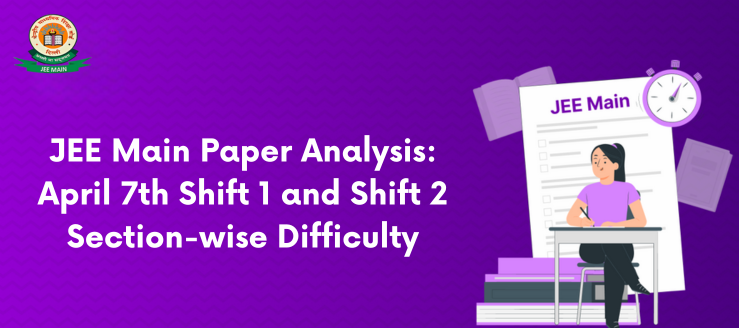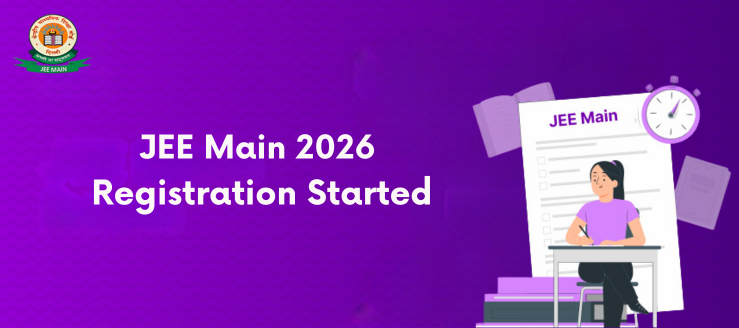
Table of Contents
The National Testing Agency (NTA) officially opened the JEE Main 2026 registration process on 21st October 2025. However, the JEE Main 2026 registration last date is on 27th November 2025. According to the new changes by NTA, all eligible candidates must ensure that their Aadhaar card contains their name, gender, date of birth, and photograph, which must be verified through the Aadhaar e-KYC system. Finally, all aspirants need to visit the official website, jeemain.nta.nic.in, to complete the JEE Main 2026 Session 1 registration.
JEE Main 2026 eligibility does not have a specific age restriction. However, candidates who aspire to get admission to the top NITs, IIITs, and GFTIs must have a minimum of 75% marks at the 10+2 level.
The NTA has already released the JEE Main 2026 exam date for Session 1, which is scheduled to be held from 21st to January 30th 2026. While Session 2 will be held from 1st to 10th April, 2026.
Note: For JEE Main 2026, NTA will utilise students’ CBSE Class 11 registration numbers to ensure the exam schedule does not overlap with the CBSE Class 12 Board exams. All CBSE-affiliated schools are required to share these registration numbers with NTA, and students must provide their Class 11 registration numbers when completing the JEE Main application form.
What’s New in JEE Main 2026?
The National Testing Agency (NTA) has introduced several significant updates for JEE Main 2026, emphasising digital modernisation, greater transparency, and broader inclusivity in the examination process.
- Live Photo Capture: During the application process, candidates will now have their live photograph captured through a webcam. This step ensures instant identity verification and eliminates the risk of fake or altered images.
- Aadhaar e-KYC Verification: The NTA will automatically verify candidate details, including name, photograph, gender, and date of birth, through Aadhaar-based e-KYC. This automation minimises manual data-entry mistakes and is expected to reduce the verification timeframe by around 25 to 30 per cent.
- Exam City Allocation via Aadhaar Address: Test centres will be assigned based on the address linked to the candidate’s Aadhaar, preventing manipulation in exam centre preferences. Additionally, the total number of examination cities has been expanded to 323 to accommodate the increased number of candidates.
- Accessible Mode for PwD Candidates: To enhance accessibility for candidates with disabilities, the NTA has added assistive options like a magnifier tool, dark mode, adjustable font size, and keyboard-based navigation using the UP and DOWN keys. These features are expected to benefit nearly 2,000–2,500 PwD candidates across the country.
What is JEE Main 2026?
JEE Main 2026 is the Joint Entrance Examination (Main) conducted for undergraduate admissions to engineering, architecture, and planning courses across India. It is organised by the National Testing Agency (NTA). It serves as the gateway for admission to prestigious institutes like NITs, IIITs, and many other centrally funded technical institutions (CFTIs), as well as numerous state and private engineering colleges.
| Particulars | Details |
| Exam Name | Joint Entrance Examination (JEE) Main 2026 |
| Organizing Authority | National Testing Agency (NTA) |
| Exam Level | National Level |
| Number of Sessions | 2 (January & April 2026) |
| Papers Offered | Paper 1: B.E./B.Tech |
| Paper 2A: B.Arch | |
| Paper 2B: B.Planning | |
| Exam Mode | Computer-Based Test (CBT) |
| Application Mode | Online |
| Paper-wise Duration | Paper 1, Paper 2A, Paper 2B: 3 hours |
| Paper 2A + 2B (both): 3 hours 30 minutes | |
| Exam Timings (Both Sessions) | First Shift: 09:00 AM to 12:00 Noon (3 hours paper) |
| 09:00 AM to 12:30 PM (3.5 hours paper) | |
| Second Shift: 03:00 PM to 06:00 PM (3 hours paper) | |
| 03:00 PM to 06:30 PM (3.5 hours paper) | |
| Exam Dates | Session 1: January 21 to 30, 2026 |
| Session 2: April 2 to 9, 2026 | |
| Official Website | https://jeemain.nta.nic.in/ |
JEE Main 2026 Important Dates
JEE Main 2026 is a critical national-level engineering entrance exam conducted by the National Testing Agency (NTA) for admission to undergraduate engineering, architecture, and planning courses. Refer to the table below for some of the important dates of both JEE Main sessions.
JEE Main 2026 Session 1 (January Session)
| Dates | Event |
| 31 October 2025 to 27 November 2025 (Up to 09:00 P.M.) | Online Submission of Application Form |
| 27 November 2025 (Up to 11:50 P.M.) | Last Date for Successful Transaction of Application Fee |
| Will be displayed on the NTA website | Correction in Application Form |
| First Week of January 2026 (Tentatively) | City Intimation Slip |
| 03–04 days before the exam date | Downloading Admit Card |
| 21 January 2026 to 30 January 2026 | Dates of Examination |
| Will be displayed on the NTA website | Display of Question Paper & Answer Keys |
| By 12 February 2026 | Declaration of Result |
JEE Main 2026 Session 2 (April Session)
| Dates | Events |
| Last week of January 2026 onwards | Online Submission of Application Form |
| Will be notified later | Last Date for Successful Transaction of Application Fee |
| Will be displayed on the NTA website | Correction in Application Form |
| Second Week of March 2026 (Tentatively) | City Intimation Slip |
| 03–04 days before the exam date | Downloading Admit Card |
| 02 April 2026 to 09 April 2026 | Dates of Examination |
| Will be displayed on the NTA website | Display of Question Paper & Answer Keys |
| By 20 April 2026 | Declaration of Result |
JEE Main 2026 Eligibility Criteria
JEE Main 2026 eligibility criteria define the essential requirements for candidates aspiring to appear in the exam. To be eligible, candidates must have passed or be appearing in their Class 12 or equivalent examination in 2024, 2025, or 2026. There is no upper age limit for applying to JEE Main 2026, making it accessible to a wide range of students. Know the detailed eligibility criteria for candidates appearing in JEE Main 2026.
- There is no age limit for appearing in JEE Main 2026.
- Candidates who passed Class 12 (or equivalent) in 2024, 2025, or are appearing in 2026 are eligible, regardless of age.
- Those who passed in 2023 or before are not eligible. The first declared passing year counts, even if marks were later improved.
- Qualifying exams include:
- 10+2 exams by recognised boards (CBSE, CISCE, state boards, etc.)
- Intermediate/Pre-University exams
- National Defence Academy two-year course
- NIOS Senior Secondary Examination (min. five subjects)
- AIU-recognised foreign or Indian equivalent exams
- AICTE/state-recognised three-year diplomas
- GCE A-Level, Cambridge High School Certificate, or IB Diploma
- BOSSE (Sikkim) recognised exams
- Candidates must confirm their eligibility directly with their preferred institutions, as the NTA is only responsible for conducting the exam.
- The state code of eligibility is based on the state where Class 12 (or equivalent) was passed, not the native place or residence.
- For NIOS students, the state of the study centre determines eligibility.
- Indian nationals from Nepal/Bhutan use their passports Indian permanent address for the state code.
- OCI candidates:
- Those passing Class 12 in India have eligibility similar to Indian nationals.
- Those educated abroad can apply only for All India quota seats, not for home-state quota seats.
Steps For JEE Main 2026 Registration
The registration process for JEE Main 2026 is a crucial first step for students seeking admission to top engineering institutes across India. The NTA conducts the exam in 2 sessions, one in January and the next one in April.
Candidates may register for the Session 1 (January 2026) examination and submit the examination fee. They will also have the option to apply later for Session 2 (April 2026) using the same application number.
However, those who wish to appear for Session 2 (April 2026) can log in and complete the fee payment during the specified application window. But, applicants who are only interested in Session 2 may register directly once the application form for Session 2 (April 2026) becomes available.
Here’s a detailed step-by-step process to help the candidates complete their JEE Main 2026 registration.

Step 1: Visit the official JEE Main website at https://jeemain.nta.nic.in/.
Step 2: Click on “Registration for JEE(Main)-2026 Session-1”.
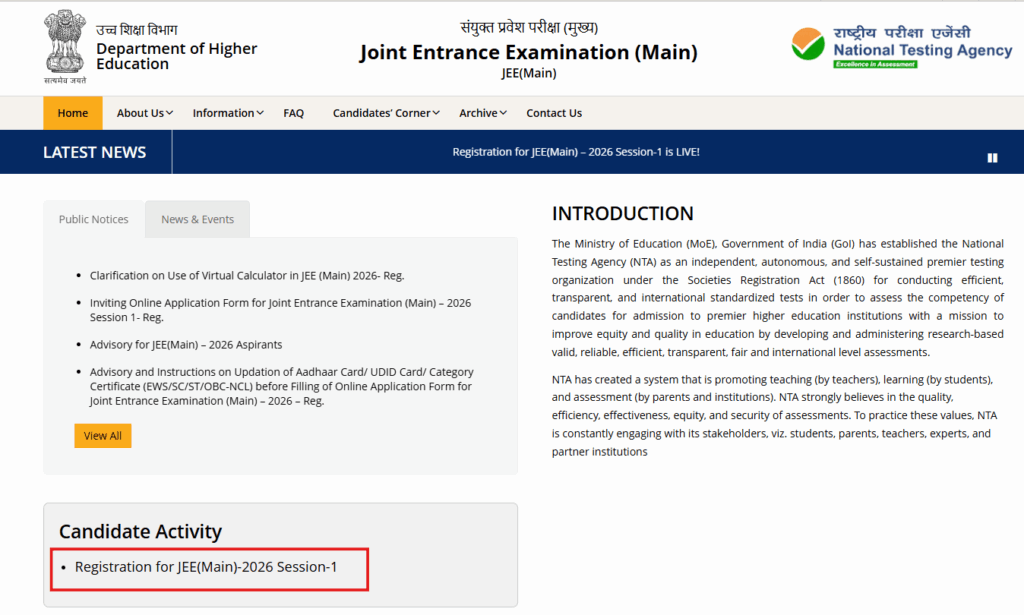
Step 3: On the next page, click on the “New Registration” if you are registering for the first time. For already Registered Candidates, click on “Log in”.
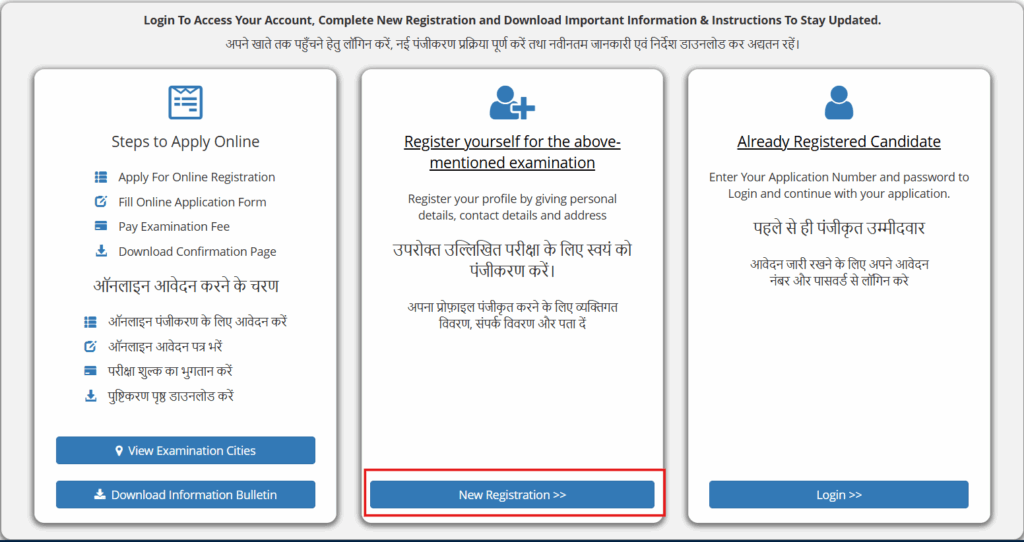
Step 4: On the next page, download the information bulletin and read all the instructions carefully. Once done, tick the check box and click the “Click Here to Process” button to complete the registration form.

Step 5: Fill out your basic details, and the system will automatically generate an Application Number. While filling out the online form, candidates must provide the required information, create a password, and select a security question along with its answer.

Step 6: After registration, candidates need to click on the “Log in”. On the next page, candidates must log in using the system-generated Application Number and the password created during registration. After logging in, candidates must complete the Application Form by entering their personal information, selecting the examination paper, choosing their preferred exam cities, providing details of their educational qualifications, and uploading any required images or documents, if applicable.
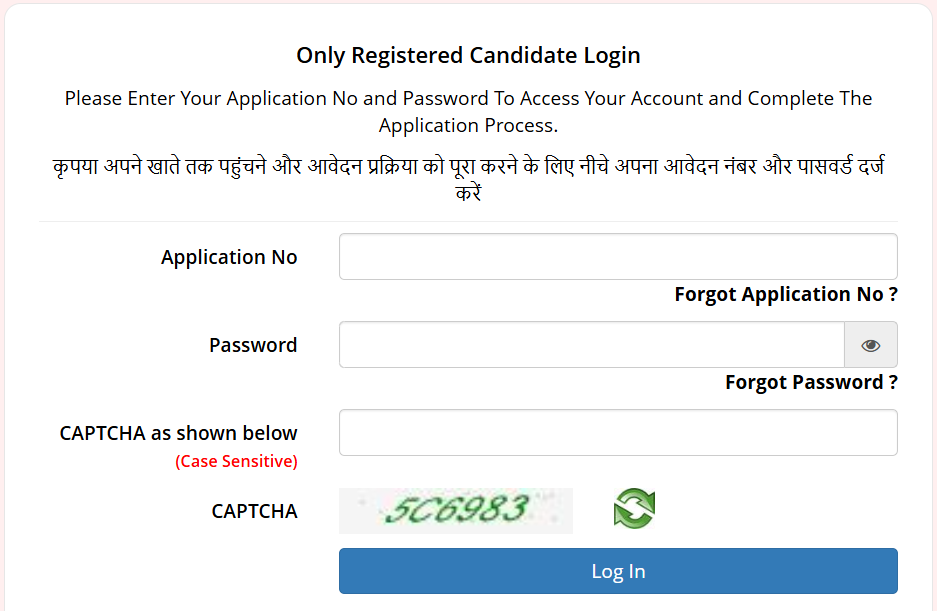
Step 7: Candidates must upload all the required documents:
- Photo (Recent colour photo with 80% face visible (no mask), white background, JPG/JPEG, 10–200 KB.)
- Signature (JPG/JPEG, 10–100 KB)
- Class 10 certificate/marks sheet (PDF, 50–300 KB)
- Identity proof (if applicable) (JPG/JPEG, 10–200 KB)
- PwD/UDID certificate (if applicable) (PDF, 50–300 KB)
Note: Upload only your own photo, signature, and documents. Any tampering or use of others’ files will be treated as Unfair Means (UFM) as per the Information Bulletin.
Step 8: Candidates must pay the required examination fee through online payment methods, including Net Banking, Credit Card, Debit Card, or UPI. The respective bank or payment gateway will charge any applicable processing fees and GST in addition to the examination fee.
| Course(s) / Paper(s) | Category/ PwD/PwBD | Gender लिंग | Fee Per Session for Candidates appearing in India (In Rs.) | Fee Per Session for Candidates appearing from Outside India (In Rs.) |
| Paper 1: B.E./B.Tech | General | Male | 1000 | 5000 |
| Female | 800 | 4000 | ||
| Gen-EWS/ OBC(NCL) | Male | 900 | 4500 | |
| Female | 800 | 4000 | ||
| SC/ST/PwD/PwBD | Male | 500 | 2500 | |
| Female | 500 | 2500 | ||
| Third Gender | 500 | 3000 | ||
| Paper 1: B.E./B.Tech | General/Gen-EWS/OBC(NCL) | Male | 2000 | 10000 |
| Female | 1600 | 8000 | ||
| SC/ST/PwD/PwBD | Male | 1000 | 5000 | |
| Female | 1000 | 5000 | ||
| Third Gender | 1000 | 5000 | ||
Step 9: Once the payment is completed, candidates can download and print their Confirmation Page. If the Confirmation Page is not generated after payment, the transaction will be considered unsuccessful. Candidates should then contact their respective banks for a refund. In such cases, candidates must make a fresh payment to complete the form submission process.
Helpline for JEE Main 2026 registration Payment-Related Queries
After filling out the JEE Main 2026 application form, candidates must pay the application fee online. For a smooth payment transaction, consider the following pointers.
- Before logging in to the application portal, ensure that your Debit or Credit Card is active and available for use. Enter the required details accurately and complete the payment using your card.
- The prescribed examination fee can be paid through any bank or payment gateway of ICICI/ HDFC/ Canara/ SBI Banks in any payment mode.
- For payments made via UPI, confirm that your linked bank account or wallet has enough funds to cover the required fee.
- If you are paying through Net Banking, verify that your account has a sufficient balance and keep your login credentials ready. Access the portal using your Net Banking ID and proceed with the payment following the given instructions.
Note: If the payment status does not display as “OK” or if the Confirmation Page for the online application is not generated after completing the fee payment, candidates should promptly contact the helpdesk or the support email of the respective bank or payment gateway provider mentioned below.
How to reset your JEE Main 2026 Application Form Password?
The password for the application form should be between 8 and 13 characters long. It must include at least one uppercase letter, one lowercase letter, one numerical digit, and one special character such as !, @, #, $, %, ^, &, *, or -. However, if you’ve forgotten your password, please refer to the options below to retrieve it.
- You can reset your password by answering the security question you set while completing the form.
- A verification code sent via SMS to your registered mobile number can be used to reset your password.
- You may also reset your password using the link sent to your registered email address.
JEE Main 2026 Exam Pattern
Each subject consists of two sections in the JEE Main 2026 exam pattern. Section A includes MCQs, while Section B features numerical answer-type questions. The exam consists of three subjects: Mathematics, Physics, and Chemistry. Each subject comprises 20 questions in Section A and 5 questions in Section B, which in total is 25 questions per subject. The total marks are 300, with each subject accounting for 100 marks.
The marking scheme for JEE Main 2026 awards +4 for every correct answer and awards -1 for each incorrect response. The same rule applies to numerical value questions, with a mark of +4 for a correct answer and -1 for an incorrect one. No marks are given for unanswered questions or those marked for review without selection.
| Subjects | Number of Questions | Marks | |
| Section A | Section B | ||
| Mathematics | 20 | 05 | 100 |
| Physics | 20 | 05 | 100 |
| Chemistry | 20 | 05 | 100 |
| Total | 75 | 300 | |
JEE Main 2026 Preparation Tips
Preparing for JEE Main 2026 requires a structured approach that balances understanding concepts, practising problems, and revising regularly. Since JEE Main serves as a gateway to premier engineering institutes, aspirants must devise a focused preparation plan tailored to their strengths and weaknesses. Consistency, time management, practising mock test papers, and clarity of concepts are key to scoring well on the exam.
- Know the Syllabus & Exam Pattern: Understand the detailed syllabus and exam pattern thoroughly for focused preparation.
- Create a Realistic Timetable: Allocate a balanced amount of time for each subject and include daily revision to reinforce concepts.
- Master NCERT Books: Focus on NCERT textbooks, especially for Chemistry, before using reference materials.
- Understand Concepts, Don’t Memorise: Prioritise conceptual clarity for effective problem solving.
- Practice JEE Main 2026 Mock Tests: Take official mock tests regularly to simulate exam conditions and identify weak areas.
- Clarify Doubts Promptly: Resolve doubts immediately to avoid disruptions.
- Analyse JEE Main PYQs: Review past JEE Main papers to know important topics and question trends.
- Manage Exam Time: Practice time management with timed test sessions to improve efficiency.
- Avoid Distractions: Minimise interruptions, such as social media, during study time to maintain focus.
- Stay Positive & Take Breaks: Keep motivated, take short breaks, and maintain a balanced routine to avoid burnout.
Comparison Of JEE Main 2026 vs JEE Main 2025 vs JEE Main 2024
The JEE Main continues to evolve each year, introducing updates to its pattern, syllabus, and schedule that impact lakhs of aspirants. A detailed comparison of JEE Main 2026, JEE Main 2025, and JEE Main 2024 helps candidates understand how the exam has progressed across sessions in terms of registration process, paper structure, eligibility guidelines, and difficulty level. This comparison provides valuable insights for students planning their preparation strategies based on recent trends and official changes announced by NTA.
JEE Main 2026
- Live Photo Capture in Application: The registration form now requires a live photo capture via webcam during application filling.
- Aadhaar e-KYC: Personal details such as name, DOB, and gender are auto-verified with Aadhaar e-KYC. Mismatches trigger a prompt to update details.
- Virtual Calculator Removed: The virtual calculator option has been withdrawn for the exam.
- Disability Document Options: Applicants can now choose to submit either UDID or disability card during registration.
- Exam Centres Updated: 33 new exam centres have been added and 7 removed, resulting in changes to the available test locations.
JEE Main 2025
- Removal of Optional Questions: All optional questions (choice-based) were removed. All 25 questions per subject are now compulsory in JEE Main 2025, including the 5 numerical questions in each subject.
- Negative Marking for Numericals: For the first time, negative marking (-1) was introduced for incorrect numerical value questions (previously, only MCQs had negative marking).
- Tie-Breaking Rules Tweaked: New tie-breaking criteria that emphasise subject-wise performance were adopted.
- Age Limit Removed: The age limit for appearing in the exam was abolished, making the exam open to all eligible candidates regardless of their age.
- Reduced Exam Centres: Some exam cities/centres were reduced for streamlining logistics.
- Syllabus Reduced: Further reductions in the prescribed syllabus were announced to align with board syllabi.
JEE Main 2024
- Official Website: NTA launched a new official website (jeemain.nta.ac.in) for applications, notifications, and updates, replacing the older NIC-hosted platform.
- Syllabus Reduction: Notable syllabus reduction was implemented, with nearly two chapters each from Physics and Mathematics removed, and about eight chapters from Chemistry eliminated, primarily aligning with changes in the Class 12 board syllabus.
- Digital Assistant: A new online chat system was introduced on the official portal to support candidates.
JEE Main Session 1: 2024 vs 2025 – Difficulty Level Comparison
Analysing the JEE Main 2025 compared to JEE Main 2024, students have observed notable shifts in the paper’s difficulty level, topic weightage, and question trends. While both sessions maintained NTA’s standard pattern, subtle differences in conceptual depth, numerical intensity, and subject-wise balance made each exam unique. This comparison highlights the evolution of overall difficulty between the sessions 1 of JEE Main 2024 and JEE Main 2025, helping aspirants understand changing exam patterns and plan their preparation more strategically for upcoming attempts.
| Criteria | JEE Main 2024 (Session 1) | JEE Main 2025 (Session 1) |
| Overall Difficulty | Moderate to Difficult | Moderate; slightly easier overall |
| Most Difficult Shift | Jan 30 – Shift 2 | Jan 28 – Shift 1 |
| Mathematics | Tough, lengthy problems | Toughest again; required time + concept clarity |
| Physics | Moderate; mix of numerical/theory | Moderate; formula + concept balanced |
| Chemistry | Easy; NCERT-based | Easiest; largely theory-based |
| Question Type Trends | Assertion-Reason, Match-the-Following | Assertion-Reason, Concept-based Direct Questions |
| Syllabus Focus | Class 11 & 12 balanced | More weight to Class 12 chapters |
| Time Management Need | Needed for lengthy Math | Crucial, especially for Mathematics |
| Student Feedback | Chemistry was scoring; Math was hard | Chemistry was predictable & easiest; Math was the most challenging |
JEE Main Qualifying Cutoff for JEE Advanced (2025 vs 2024)
The JEE Main qualifying cutoff represents the minimum NTA percentile required for a candidate to qualify for JEE Advanced. These cutoffs fluctuate annually based on factors like exam difficulty and normalisation methods. Only the top 2.5 lakh candidates across categories who meet the specified percentile are eligible to register for JEE Advanced.
For 2025, the overall cutoffs saw an upward shift due to increased competition and stronger average scores across exam sessions. The General category cutoff rose by approximately 2.3 percentile points, indicating stiffer eligibility standards. Reserved categories such as SC and ST also showed notable improvements, reflecting either enhanced candidate performance or favourable normalisation trends.
| Category | Cutoff Percentile (2025) | Cutoff Percentile (2024) |
| General (UR) | 93.10 | 90.77 |
| EWS | 80.38 | 75.62 |
| OBC-NCL | 79.43 | 73.61 |
| SC | 61.15 | 51.97 |
| ST | 47.90 | 37.23 |
| PwD | 0.008 | 0.001 |
Frequently Asked Questions
1. Is JEE Main 2026 registration started?
Yes, the JEE Main 2026 registration process started on 21st October 2025 and will continue until 27th November 2025. Candidates can register online at the official NTA website.
2. What are the JEE Main 2026 eligibility criteria?
Candidates must have passed Class 12 or an equivalent examination in 2024, 2025, or be appearing in 2026. There is no upper age limit. For admission to NITs, IIITs, and GFTIs, a minimum of 75% marks in Class 12 is required (65% for SC/ST candidates).
3. What is the official website to register for JEE Main 2026?
The official website for JEE Main 2026 registration is jeemain.nta.nic.in, where candidates must complete the registration process, fill out the form, upload the required documents, and pay the applicable fee.
4. When will the JEE Main 2026 exam be held?
Session 1 of JEE Main 2026 is scheduled from January 21 to 30, 2026, and Session 2 will be held from April 1 to 10, 2026.
5. What documents are required for JEE Main 2026 registration?
Candidates must have an Aadhaar card for e-KYC verification, a recent photograph with at least 80% of their face visible, a signature, a Class 10 certificate, and, if applicable, PwD/Category certificates. Live photo capture via webcam is mandatory during registration.
6. How is the Aadhaar e-KYC used in JEE Main 2026 registration?
NTA verifies candidate details, including name, gender, date of birth, and photograph, using Aadhaar-based e-KYC to ensure accuracy and authenticity, thereby reducing manual errors and fraud.
7. What is the fee structure for JEE Main 2026 registration?
The fee varies by category and paper choice. For example, General male candidates pay INR 1000 for one paper and INR 2000 for two papers, with lower fees for female, SC/ST/PwD categories. Payment is done online via net banking, credit/debit card, or UPI.
8. Is there a prerequisite for CBSE students in JEE Main 2026 registration?
Yes, CBSE Class 11 registration numbers are required to avoid exam schedule conflicts with Class 12 Board exams. Students must provide this number for the JEE Main 2026 registration process and filling out the application form.
9. How is the exam city allocated for JEE Main 2026?
Test centres will be allotted based strictly on the address linked to the candidate’s Aadhaar card, preventing manipulation of exam city preferences. The number of exam cities has also expanded to 323 to accommodate a larger number of candidates.
10. What new assistive features have been added for PwD candidates in JEE Main 2026?
NTA has introduced assistive digital tools for candidates with disabilities, including a magnifier tool, dark mode, adjustable font size, and keyboard navigation using UP and DOWN keys to enhance exam accessibility.
11. Can candidates without an Aadhaar card register for JEE Main 2026?
Candidates without Aadhaar can still register by submitting other valid identity proofs; however, they will not have the advantage of automatic e-KYC and may be subject to manual or physical verification.
12. Are there any challenges faced by JEE Main 2026 candidates due to the live photo and Aadhaar e-KYC verification process?
Yes, some candidates have faced difficulties uploading their live photo due to mismatches with the Aadhaar database, which can only be resolved by updating their Aadhaar details at the relevant centres.



